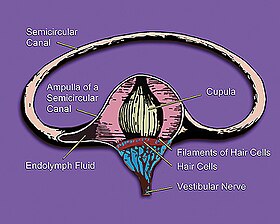Ductus semicirculares
| Semicircular canal | |
|---|---|

The internal ear, with "semicircular ducts" at left
|
|

Inner ear illustration showing semicircular canal, hair cells, ampulla, cupula, vestibular nerve, & fluid
|
|
| Details | |
| Artery | stylomastoid artery, labyrinthine artery |
| Identifiers | |
| Latin | canalis semicircularis |
| MeSH | A09.246.63 |
| TA | A15.3.03.015 |
| FMA | 60186 75362, 60186 |
|
Anatomical terminology
[]
|
|
The semicircular canals or semicircular ducts are three semicircular, interconnected tubes located in the innermost part of each ear, the inner ear. The three canals are the horizontal, superior and posterior semicircular canals.
The semicircular canals are a component of the bony labyrinth. At one end of each of the semicircular canals is a dilated sac called an osseous ampulla which is more than twice the diameter of the canal. Each ampulla contains an ampulla crest, the crista ampullaris which consists of a thick gelatinous cap called a cupula and many hair cells. The superior and posterior semicircular canals are oriented vertically at right angles to each other. The lateral semicircular canal is about a 30-degree angle from the horizontal plane. The orientations of the canals cause a different canal to be stimulated by movement of the head in different planes. The horizontal canal detects angular acceleration of the head when the head is turned and the superior and posterior canals detect vertical head movements when the head is moved up or down. When the head changes position, the endolymph in the canals lags behind due to inertia and this acts on the cupula which bends the cilia of the hair cells. The stimulation of the hair cells sends the message to the brain that acceleration is taking place. The ampullae open into the vestibule by five orifices, one of the apertures being common to two of the canals.
Among species of mammals, the size of the semicircular canals is correlated with their type of locomotion. Specifically, species that are agile and have fast, jerky locomotion have larger canals relative to their body size than those that move more cautiously.
The lateral or horizontal canal (external semicircular canal) is the shortest of the three canals. Movement of fluid within this canal corresponds to rotation of the head around a vertical axis (i.e. the neck), or in other words rotation in the transverse plane. This occurs, for example, when you turn your head to the left and right hand sides before crossing a road
It measures from 12 to 15 mm., and its arch is directed horizontally backward and laterally; thus each semicircular canal stands at right angles to the other two. Its ampullated end corresponds to the upper and lateral angle of the vestibule, just above the oval window, where it opens close to the ampullated end of the superior canal; its opposite end opens at the upper and back part of the vestibule. The lateral canal of one ear is very nearly in the same plane as that of the other; while the superior canal of one ear is nearly parallel to the posterior canal of the other.
...
Wikipedia
